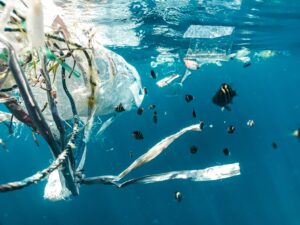
Researchers use bacteria to biodegrade marine plastics

Our oceans are drowning in plastic. At least 14 million tonnes of plastic ends up in the ocean every year, and plastic now makes up about 80 per cent of all marine pollution. By 2050, marine plastics will have outweighed the total mass of fish in the world’s oceans.
One team of researchers at the University of California Santa Barbara (UCSB) are working to find a solution: using nature to create biodegradable plastics.
“We are looking to make a bioplastic material that degrades in the ocean,” UCSB marine microbiologist Alyson Santoro explains to Marine Industry News. “Our initial goal is to explore the use of these materials in expendable oceanographic sensors.”
Oceanographic sensors are deployed in the ocean by companies and research institutes to monitor anything from ocean temperature and salinity to tide levels and weather. While many sensors are deployed each year, it’s generally more cost-effective for companies and institutions not to attempt to retrieve them and make new ones instead.
Santoro is collaborating with Melissa Omand from the University of Rhode Island, Anne Meyer from the University of Rochester and the bioplastics company Mango Materials to investigate microbes that have been found to break down plastics.

“Organisms that degrade the specific material we are working with – polyhydroxybutyrate or PHB – are naturally occurring in the ocean,” says Santoro (pictured left).
“This material is unlike most petroleum-based plastics in that it is a material that some bacteria make naturally as a way to store energy. Similarly, some bacteria have evolved a way to break down this same material as a food and energy source.”
While plastics billed as “biodegradable” are available on the mass market, they are designed to degrade at relatively high temperatures in industrial composting facilities.
“Most of the ocean is about 4ºC, and those materials can persist for decades or longer there,” Santoro says. “So we are exploring using PHB in conjunction with naturally occurring bacteria that degrade PHB to design a material that is truly biodegradable in the ocean.”
The project is understood to be a first. “Some researchers have successfully embedded enzymes in some plastic materials to enhance their degradation, but this has only been tested in terrestrial environments. As far as I know, we are the first to explore this specifically for marine applications,” Santoro says.
While Santoro points out that oceanographic instruments and sensors represent a “vanishingly small” part of the overall plastic pollution problem, she says it makes sense to target these communities to become “early adopters” of biodegradable options. “We hope that the technology will permeate other industries.”

Photo courtesy of Sofar Ocean
The UCSB associate professor says she is confident her team can develop several different materials that are truly biodegradable in the ocean. “The challenge right now is finding the right applications, where the required endurance of the product is in line with the lifetime of the material and where manufacturers can afford to pay a bit extra for a biodegradable option.”
Santoro and her team have so far secured a “Phase I” grant, which will run for one year, concluding in October. “At this stage, it is more of a feasibility study. If we are successful at getting a Phase II award, we will continue to more useable products in the following 3-5 years,” she says.
While it’s thrilling to imagine microbes harmlessly breaking down marine plastics, Santoro clarifies that these findings do not represent an alternative to reducing waste in the first place.
“I think [this project] is just one piece of what needs to be a multi-pronged approach; one that would ideally involve using less plastic to start with,” she says.
